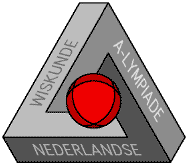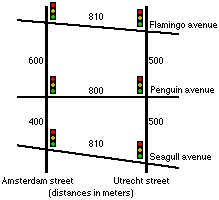 Math A-lympiad:
Preliminary 1990-1991
Math A-lympiad:
Preliminary 1990-1991
The green wave
 |
The green wave
Introduction
In the above map the Amsterdam street and Utrecht street are the main streets
with a maximum speed of 30 mph. At the intersections with the Flamingo-,
Pinguin- and Seagull avenues are traffic lights. To get a smooth as possible
traffic flow and to minimize irritation with traffic participators it is
considered important that the waiting time for red lights is minimized.
If a driver has a green light he should catch a green light at the next
intersection just as he arrives and so on for the next light. In this case
we talk of a 'green wave'. To get as close as possible to a green wave
situation one has to consider for instance:
-
the duration of the green, yellow and red light periods
-
the relation between the different intersections
-
the indication of advised travel speeds
It is known that a traffic light cannot be red for more than 90 seconds
at a time and that each green period should be minimal 5 seconds. On the
average the traffic on the main streets is four times as intensive as on
the avenues.
Exercise
Give advise as how to adjust the traffic lights for each of the following
subsequently more complex situations:
-
Bicyclists on the Utrecht street from north to south should have a green
wave.
-
Both bicyclists and cardrivers should have a green wave from north to south
on the Utrecht street.
-
Both north and south traffic (cars and bicycles) on the Utrecht street
should have a green wave as good as possible.
-
Both north and south traffic (cars and bicycles) on the Utrecht- and Amsterdam
streets should have a green wave as good as possible. Take also into consideration
the traffic on the Flamingo-, Penguin- and Seagull avenues; this traffic
should have a reasonable flow too.
Which general principles and considerations should you use in general and
more complex situations?
 Math A-lympiad:
Preliminary 1990-1991
Math A-lympiad:
Preliminary 1990-1991 Math A-lympiad:
Preliminary 1990-1991
Math A-lympiad:
Preliminary 1990-1991